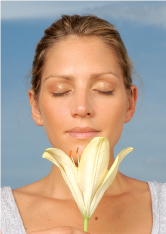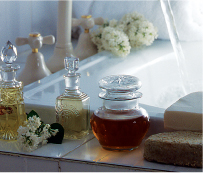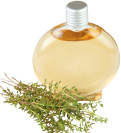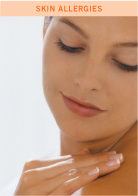Healthy aromas
Aromatherapy is the practice of therapeutically using pure aromas, as a natural treatment for a number of disorders, among them allergies. This treatment is a good complementary therapy to help to reestablish physical and psychological balance and harmony. Listed below are a number of tips for using natural essences correctly in allergy treatment.

+ Aromatherapy is a holistic discipline that uses essential oils naturally extracted from plants for their therapeutic effects. Many studies have revealed that the sense of smell is the deepest physical sense that we have which has a powerful influence over our bodies and emotions.
For treating allergies, using essential oils can bring a number of excellent benefits. From the emotional point of view, they help to relieve the tensions and anxiety brought on by allergic reactions. Using aromatherapy may help to prevent tension. From a physical point of view, beyond helping to relieve certain symptoms, aromatherapy stimulates the immune system, increasing the body's defense mechanisms. It's important to be aware that only pure, natural, non-imitated essential oils have medicinal properties for effective treatment. Perfumes, shampoos and bath lotions with herbs, although they have a pleasant aroma, don't have therapeutic actions.
MODES OF USE
∎ Vaporizers. This is another effective treatment for respiratory problems provoked by allergies. This treatment uses essential oils to penetrate the aroma in a room, using an oil burner or clay pot. Add between 5 to 8 drops of an essential oil and allow to evaporate. With this method do not use a vehicle or neutral oils, because they can overheat and give off an unpleasant aroma.
∎ Baths. Very useful in relieving tensions and unpleasant symptoms brought on by allergies. Fill a bathtub with hot water and add a few drops of aromatherapy oil and soak in the water. It's advised that you keep the doors and windows closed, so that the aroma from the oil and steam don't escape the bathroom. For a home made bath oil, mix 3 tablespoons of a neutral oil such as sweet almond oil and 50 drops of essential oil or a blend of essentials. Keep in a colored glass bottle. Use 1 to 2 teaspoons to each bath. To add essential oils directly to a bath use 4 to 8 drops.
∎ Massages. The chemical compounds of essential oils can be absorbed into the skin, then entering the blood stream to produce chemical reactions similar to some medications.

VAPORS
This may be the best way to treat respiratory problems related to allergies such as hay fever. Fill a glass or a large cup half full with water almost on the boil and add 3 drops of an essential oil. Cover your head with a towel, close your eyes and breath in the

A RECIPE FOR EACH DISCOMFORT
Aromatherapy can be especially useful in treating skin allergies because aromatherapy is primarily a topical therapy. At the same time it's very effective for respiratory discomforts in the form of steam baths or vapor treatment. We've put together a practical guide with recipes to help relieve the discomforts brought on by a number of allergies.
For the respiratory system
If you want to relieve respiratory tract discomforts, use thyme essential oil added to vapor treatments or a hot bath.
When blending oils you shouldn't mix essential oils that have opposite therapeutic effect or use more than 3 or 4 oils at a time. A blend should be pleasant.

Night time inhalation

Inhaling vapor with 2 or 3 drops of essential oil of eucalyptus, thyme, rosemary or mint added is very effective for asthma. It's recommended using this treatment before going to bed. During spring and summer, when you suffer from seasonal hay fever, we recommend placing an aromatherapy clay pot or vaporizer with essential oil in your bedroom.
Relieving congestion
To get rid of excess mucus caused by an allergic reaction, you can externally massage your nostrils and sinuses using essential oil of lavender, sweet thyme, hyssop, cypress, and eucalyptus blended with sweet almond oils. If you like, you can use the same essential oils for inhalations.
Balsamic cream
For slight eczema in a specific area or all over the body. It's best to use a non-fragrant free lotion or cream suited to sensitive skin. Use 1 teaspoon of cream or lotion with 2 drops of camomile and 2 drops of lavender. You can increase the amount of essential oils, up to 10 drops if the skin reacts favorably.
Back and chest massage
Mix 5 drops of essential oil of thyme and 5 drops of essential oil of eucalyptus with 2 teaspoons of olive or sunflower oil. Massage on the chest and back up to twice a day. While giving or receiving a massage, add 5-10 drops of oil to a clay pot for 30 minutes for vaporization.
SKIN ALLERGIES

Essential oils shouldn't be applied directly to the skin, especially if you have sensitive skin or are suffering from skin problems. Dilute in a neutral, or vehicle oil such as sunflower or almond oil. Use a proportion of 1 part essential oil to 20 parts neutral oil. For example: 5 drops of essential oil to 1 teaspoon of neutral oil. You can use a blend of geranium, clary sage and thyme gently applied to the affected area for a potentially beneficial relief.

Comment about this article, ask questions, or add new information about this topic: